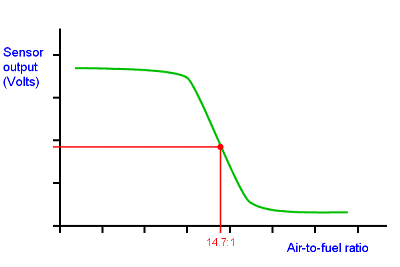It's a common question, and you're probably reading this because you have the same question. The bottom-line is that the way wideband sensors are engineered, they provide no meaningful wideband air-fuel ratio data by themselves. By itself, that statement seems ludicrous. I mean, there must be some information that the controller receives to get wideband data, so why can't the gauge do it directly? Let's discuss this.
Narrowband oxygen sensors
Let's start with a brief understanding of narrow-band oxygen sensors. This graph shows the typical output from a narrow-band oxygen sensor:

The red point is the stoichiometric air-to-fuel ratio (AFR) point, ie: the point at which there is a matching amount of air and fuel for complete combustion, and is 14.7 to 1 for gasoline. Where the ends of the curve become horizontal, you can see that there's little if any change in output for a change in AFR, so it becomes unmeasureable in those areas. The middle section where the line slopes is very measureable, but is VERY small... ie: the AFR band is very narrow. For all intents and purposes, this narrowband sensor can only indicate if the AFR is below (rich), at (stoich) or above (lean) the ideal AFR point.
The voltage output of the sensor at which the stoichiometric point occurs is around 0.45V. The usable output range is around 0.1V (lean) to 0.9V (rich).
Wideband oxygen sensors
Wideband oxygen sensors actually make use of a narrowband sensor, but with some additions. Specifically there is a control input on the sensor that allows the stoich point to the shifted rich or lean, based on how much current is injected into that control input. This means that with a specific amount of control, the sensor can behave like a 13.5:1 stoich sensor for example. So the output would be 0.45 Volts at 13.5 AFR. Or it can be made to be leaner than 14.7:1 AFR. The changeable range is about -50% to +50% for a common Bosch wideband O2 sensor.
Now, a wideband sensor HAS the ability to detect and measure air-fuel ratios other than 14.7, but it requires a varying control to do so. This is the job of a wideband controller. It dynamically and VERY rapidly adjusts the amount of current to the sensor control input to get an output of 0.45 Volts. At that point, the controller knows what AFR ratio is stoichiometric for the amount of current injected into the control input, and can calculate the air-to-fuel ratio from that. This is typically puts out as a varying analog voltage for a gauge or ECU.
And there it is... without a controller, the wideband sensor is not very useful. The controller also performs other important functions such as heating the sensor, so it gets to it's operational temperature much quicker (compared to waiting for it to heat up due to exhaust gas alone). OEM ECUs typically have a controller built in, but aftermarket ECUs usually have these as standalone boxes.

Follow us